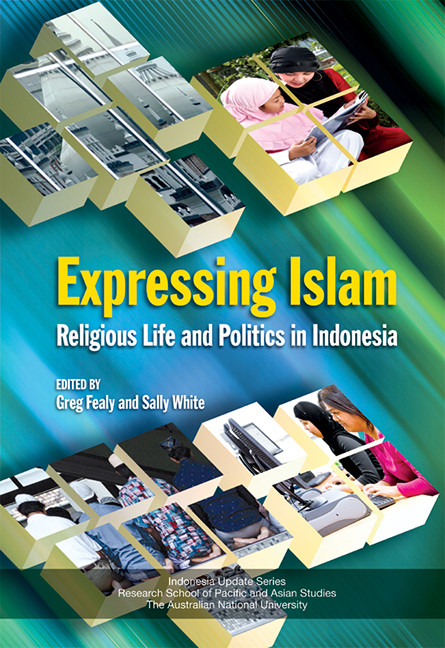Book contents
- Frontmatter
- Contents
- List of Figures and Tables
- List of Contributors
- Acknowledgments
- Glossary
- Map
- 1 Introduction
- PART I EXPRESSING PERSONAL PIETY
- 2 Consuming Islam: Commodified Religion and Aspirational Pietism in Contemporary Indonesia
- 3 Modulations of Active Piety: Professors and Televangelists as Promoters of Indonesian ‘Sufisme’
- 4 Throwing Money at the Holy Door: Commercial Aspects of Popular Pilgrimage in Java
- 5 ‘Spiritual Meal’ or Ongoing Project? The Dilemma of Dakwah Oratory
- 6 Marketing Morality: The Rise, Fall and Rebranding of Aa Gym
- PART II POLITICAL, SOCIAL AND LEGAL EXPRESSIONS OF ISLAM
- PART III THE ISLAMIC ECONOMY
- Index
- Indonesia Update Series
- Plate section
3 - Modulations of Active Piety: Professors and Televangelists as Promoters of Indonesian ‘Sufisme’
from PART I - EXPRESSING PERSONAL PIETY
Published online by Cambridge University Press: 21 October 2015
- Frontmatter
- Contents
- List of Figures and Tables
- List of Contributors
- Acknowledgments
- Glossary
- Map
- 1 Introduction
- PART I EXPRESSING PERSONAL PIETY
- 2 Consuming Islam: Commodified Religion and Aspirational Pietism in Contemporary Indonesia
- 3 Modulations of Active Piety: Professors and Televangelists as Promoters of Indonesian ‘Sufisme’
- 4 Throwing Money at the Holy Door: Commercial Aspects of Popular Pilgrimage in Java
- 5 ‘Spiritual Meal’ or Ongoing Project? The Dilemma of Dakwah Oratory
- 6 Marketing Morality: The Rise, Fall and Rebranding of Aa Gym
- PART II POLITICAL, SOCIAL AND LEGAL EXPRESSIONS OF ISLAM
- PART III THE ISLAMIC ECONOMY
- Index
- Indonesia Update Series
- Plate section
Summary
A distinctive and remarkable feature of Indonesia's recent Islamic revival has been the upsurge of popular interest in Islam's mystical and devotional tradition, tasawwuf (Sufism). The resurgence of Sufism, especially among urbanites, during Indonesia's Islamic revival runs counter to the powerful current of scripturalist Islamic modernism that has been hostile to Sufism for most of the past century. Modernist reformers, prominent in cities in organisations such as Muhammadiyah, commonly thought that tasawwuf encouraged violations of the core doctrine of the oneness of God through excessive adulation of the masters (syekh) of the Sufi religious orders (tarekat). Muslim modernists also objected to certain discretionary prayers (shalat sunnat) that Sufis appended to Islam's obligatory prayers (shalat wajib). Not only did modernists find no scriptural precedent for such additions, and therefore branded them heretical inventions (bid'ah), but they judged the ‘irrational’, emotive and mystical states that the repetitive Sufi prayers could evoke to be out of keeping with the modern temper Muslims must cultivate to regain their proper place in the world.
In the Middle East, the scripturalist and, increasingly, Salafist character of Islamic modernism was heightened in the middle to late twentieth century as disappointment with secular ideologies of social transformation and social justice fuelled the popularity of political Islam. Global currents of Salafist thought, which gained prominence during the latter twentieth-century Islamic revival, have reinforced the suspicions of Sufism already raised by more moderate modernist Muslims. Such anti-Sufi agitation has played a part in Indonesia's Islamic revival, as it has in Islamic revivals elsewhere.
Nonetheless, as the twenty-first century unfolds, it is clear that Sufism has not disappeared from Muslim communities across the world, and is showing new vigour in many places where it had languished in the shadow of other articulations of Islam with stronger public recognition as ‘orthodox’ (Howell and van Bruinessen 2007). Indonesia is one of the places where Sufism appeared to be in decline by the middle of the twentieth century, but its resurgence in the last three decades of the century is now widely acknowledged and a matter of much discussion.
- Type
- Chapter
- Information
- Expressing IslamReligious Life and Politics in Indonesia, pp. 40 - 62Publisher: ISEAS–Yusof Ishak InstitutePrint publication year: 2008

